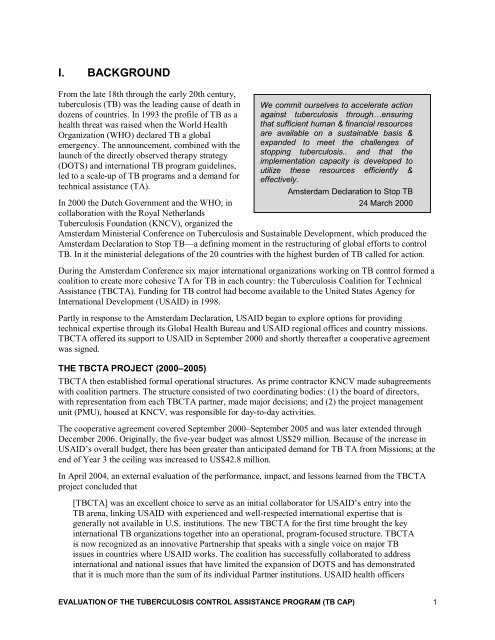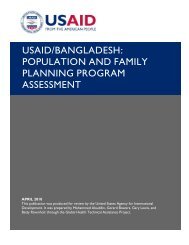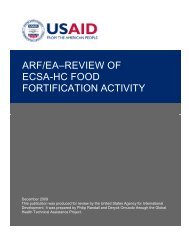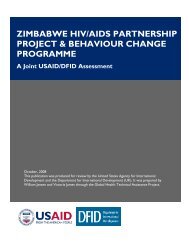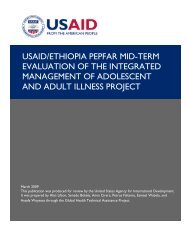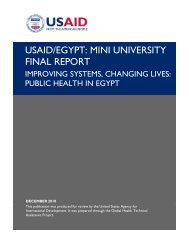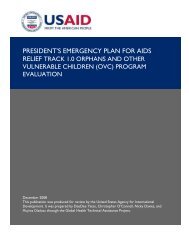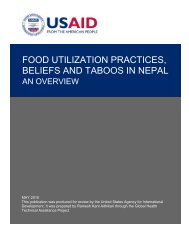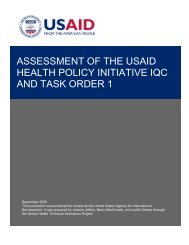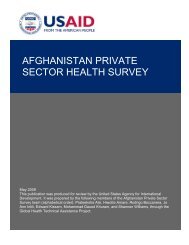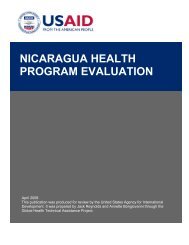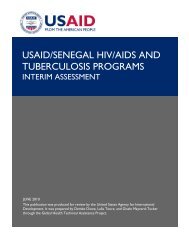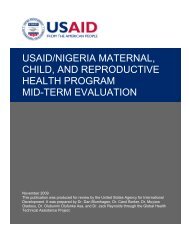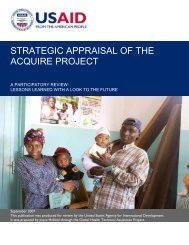Evaluation of the Tuberculosis Control Assistance Program (TB CAP)
Evaluation of the Tuberculosis Control Assistance Program (TB CAP)
Evaluation of the Tuberculosis Control Assistance Program (TB CAP)
You also want an ePaper? Increase the reach of your titles
YUMPU automatically turns print PDFs into web optimized ePapers that Google loves.
I. BACKGROUNDFrom <strong>the</strong> late 18th through <strong>the</strong> early 20th century,tuberculosis (<strong>TB</strong>) was <strong>the</strong> leading cause <strong>of</strong> death indozens <strong>of</strong> countries. In 1993 <strong>the</strong> pr<strong>of</strong>ile <strong>of</strong> <strong>TB</strong> as ahealth threat was raised when <strong>the</strong> World HealthOrganization (WHO) declared <strong>TB</strong> a globalemergency. The announcement, combined with <strong>the</strong>launch <strong>of</strong> <strong>the</strong> directly observed <strong>the</strong>rapy strategy(DOTS) and international <strong>TB</strong> program guidelines,led to a scale-up <strong>of</strong> <strong>TB</strong> programs and a demand fortechnical assistance (TA).In 2000 <strong>the</strong> Dutch Government and <strong>the</strong> WHO, incollaboration with <strong>the</strong> Royal Ne<strong>the</strong>rlands<strong>Tuberculosis</strong> Foundation (KNCV), organized <strong>the</strong>We commit ourselves to accelerate actionagainst tuberculosis through…ensuringthat sufficient human & financial resourcesare available on a sustainable basis &expanded to meet <strong>the</strong> challenges <strong>of</strong>stopping tuberculosis.. and that <strong>the</strong>implementation capacity is developed toutilize <strong>the</strong>se resources efficiently &effectively.Amsterdam Declaration to Stop <strong>TB</strong>24 March 2000Amsterdam Ministerial Conference on <strong>Tuberculosis</strong> and Sustainable Development, which produced <strong>the</strong>Amsterdam Declaration to Stop <strong>TB</strong>—a defining moment in <strong>the</strong> restructuring <strong>of</strong> global efforts to control<strong>TB</strong>. In it <strong>the</strong> ministerial delegations <strong>of</strong> <strong>the</strong> 20 countries with <strong>the</strong> highest burden <strong>of</strong> <strong>TB</strong> called for action.During <strong>the</strong> Amsterdam Conference six major international organizations working on <strong>TB</strong> control formed acoalition to create more cohesive TA for <strong>TB</strong> in each country: <strong>the</strong> <strong>Tuberculosis</strong> Coalition for Technical<strong>Assistance</strong> (<strong>TB</strong>CTA). Funding for <strong>TB</strong> control had become available to <strong>the</strong> United States Agency forInternational Development (USAID) in 1998.Partly in response to <strong>the</strong> Amsterdam Declaration, USAID began to explore options for providingtechnical expertise through its Global Health Bureau and USAID regional <strong>of</strong>fices and country missions.<strong>TB</strong>CTA <strong>of</strong>fered its support to USAID in September 2000 and shortly <strong>the</strong>reafter a cooperative agreementwas signed.THE <strong>TB</strong>CTA PROJECT (2000–2005)<strong>TB</strong>CTA <strong>the</strong>n established formal operational structures. As prime contractor KNCV made subagreementswith coalition partners. The structure consisted <strong>of</strong> two coordinating bodies: (1) <strong>the</strong> board <strong>of</strong> directors,with representation from each <strong>TB</strong>CTA partner, made major decisions; and (2) <strong>the</strong> project managementunit (PMU), housed at KNCV, was responsible for day-to-day activities.The cooperative agreement covered September 2000–September 2005 and was later extended throughDecember 2006. Originally, <strong>the</strong> five-year budget was almost US$29 million. Because <strong>of</strong> <strong>the</strong> increase inUSAID’s overall budget, <strong>the</strong>re has been greater than anticipated demand for <strong>TB</strong> TA from Missions; at <strong>the</strong>end <strong>of</strong> Year 3 <strong>the</strong> ceiling was increased to US$42.8 million.In April 2004, an external evaluation <strong>of</strong> <strong>the</strong> performance, impact, and lessons learned from <strong>the</strong> <strong>TB</strong>CTAproject concluded that[<strong>TB</strong>CTA] was an excellent choice to serve as an initial collaborator for USAID’s entry into <strong>the</strong><strong>TB</strong> arena, linking USAID with experienced and well-respected international expertise that isgenerally not available in U.S. institutions. The new <strong>TB</strong>CTA for <strong>the</strong> first time brought <strong>the</strong> keyinternational <strong>TB</strong> organizations toge<strong>the</strong>r into an operational, program-focused structure. <strong>TB</strong>CTAis now recognized as an innovative Partnership that speaks with a single voice on major <strong>TB</strong>issues in countries where USAID works. The coalition has successfully collaborated to addressinternational and national issues that have limited <strong>the</strong> expansion <strong>of</strong> DOTS and has demonstratedthat it is much more than <strong>the</strong> sum <strong>of</strong> its individual Partner institutions. USAID health <strong>of</strong>ficersEVALUATION OF THE TUBERCULOSIS CONTROL ASSISTANCE PROGRAM (<strong>TB</strong> <strong>CAP</strong>) 1


